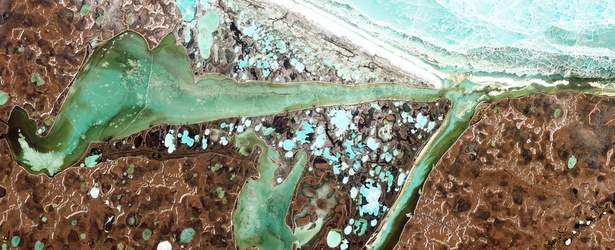Research finds Arctic thermokarst lakes are “net climate coolers”, contradicts widely-held scientific view

A recently published study in journal Nature, and supported by National Science Foundation (NSF), counters a widely-held scientific view that thawing permafrost uniformly accelerates atmospheric warming. Instead, the study indicates that certain Arctic lakes store more greenhouse gases than they emit into the atmosphere.
The study focuses on thermokarst lakes, which occur as permafrost thaws and creates surface depressions that fill with melted fresh water, converting what was previously frozen land into lakes.
It suggests that Arctic thermokarst lakes are "net climate coolers" when observed over longer, millennial, time scales.
"Until now, we've only thought of thermokarst lakes as positive contributors to climate warming," said lead researcher Katey Walter Anthony, associate research professor at the University of Alaska Fairbanks Institute of Northern Engineering. "It is true that they do warm climate by strong methane emissions when they first form, but on a longer-term scale, they switch to become climate coolers because they ultimately soak up more carbon from the atmosphere than they ever release."
The researchers observed that roughly 5 000 years ago, thermokarst lakes in ice-rich regions of North Siberia and Alaska began cooling, instead of warming the atmosphere.
"While methane and carbon dioxide emissions following thaw lead to immediate radiative warming," the authors write, "carbon uptake in peat-rich sediments occurs over millennial time scales."
Using published data from the circumpolar Arctic, their own new field observations of Siberian permafrost and thermokarsts, radiocarbon dating, atmospheric modeling and spatial analyses, the research team studied how thawing permafrost is affecting climate change and greenhouse gas emissions.
Researchers found that "thermokarst basins switched from a net radiative warming to a net cooling climate effect about 5,000 years ago," according to their article. They found that high rates of carbon accumulation in lake sediments were stimulated by several factors, including "thermokarst erosion and deposition of terrestrial organic matter, nutrient release from thawing permafrost that stimulated lake productivity, and by slow decomposition in cold, anoxic lake bottoms."
"These lakes are being fertilized by thawing yedoma permafrost," explained co-author Miriam Jones, a research geologist for the USGS. Yedoma is a type of permafrost that is rich in organic material. "So mosses and other plants flourish in these lakes, leading to carbon uptake rates that are among the highest in the world, even compared to carbon-rich peatlands."
Source: NSF
Reference:
"A shift of thermokarst lakes from carbon sources to sinks during the Holocene epoch" – K. M. Walter Anthony, S. A. Zimov, G. Grosse, M. C. Jones, P. M. Anthony, F. S. Chapin III, J. C. Finlay, M. C. Mack, S. Davydov, P. Frenzel & S. Frolking- Nature 511, 452–456 (24 July 2014) doi:10.1038/nature13560
Featured image: Omulyakhskaya and Khromskaya Bays, Northern Siberia. Image taken on August 11, 20144 by Landsat 5 – TM. Credit: NASA GSFC

Commenting rules and guidelines
We value the thoughts and opinions of our readers and welcome healthy discussions on our website. In order to maintain a respectful and positive community, we ask that all commenters follow these rules:
We reserve the right to remove any comments that violate these rules. By commenting on our website, you agree to abide by these guidelines. Thank you for helping to create a positive and welcoming environment for all.